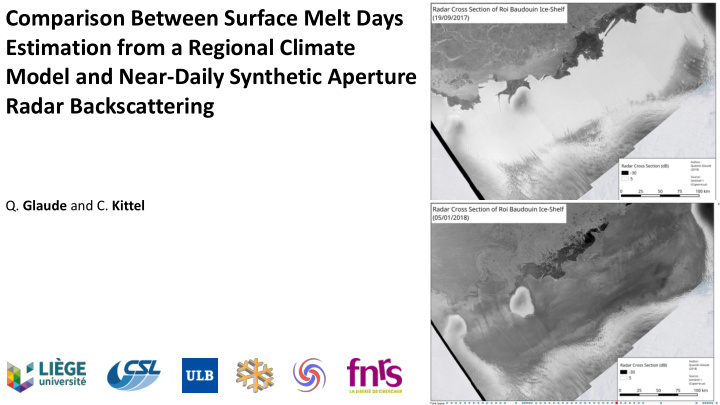



Comparison Between Surface Melt Days Estimation from a Regional Climate Model and Near-Daily Synthetic Aperture Radar Backscattering Q. Glaude and C. Kittel
The methodology is applied in Dronning Maud Land – East Antarctica, but is also applicable elsewhere
Antarctica is losing mass at an increasing rate, and requires a monitoring of its key variables such as surface melt 1980-1990 : -40 Gt/a 1990-2000 : -50 Gt/a 2000-2010 : -144 Gt/a 2010-2020 : -252 Gt/a → 6x more loss is 30 years [E. Rignot et al., 2019]
The Regional Climate Model (MAR) is able to model the surface melt in Antarctica
Using time series on the entire continent, we can compute the whole ice melt coverage
These models constitute predictions based on our current knowledge of the geophysics and need to be verified → This is now possible with Remote Sensing using the very high revisit rate of current satellites
SAR is an imaging technique where a spaceborne sensor emits an electromagnetic wave and captures its return [Copernicus, 2019]
SAR Remote Sensing is independent of the Sun’s Illumination, which allows to work day-and-night, crucial in polar regions Optical Image SAR Image [De Luca, C. 2017]
Surface melt can be observed using Radar Backscattering / Radar Cross Section (through changes of the dielectric constant) Melting period : → strong decrease in radar cross section
Using time series on a given region, we can observe melt periods at very high spatial resolution and time Play button →
Time series analysis of Radar Cross Section (RCS) allows the estimation of melt days per year and pear region
Preliminary results show a strong correlation between the RCS and the predicted surface melt from MAR
RCS is also correlated to rainfalls, since backscattering is impacted by surface moisture
Similarly, there is a net correlation between RCS and water content (1 st meter)
There is a positive correlation between RCS and albedo, although RCS is less variable
There is a low negative correlation between Radar Cross Section (RCS) and snowfall (less snowfall in melt periods)
To conclude, preliminary analysis compares SAR observations with MAR predictions. End goal of the project is to refine MAR by analyzing prediction anomalies 1. Statistical analysis : What is the difference between the number of melt days predicted by MAR and observed by SAR ? 2. Geospatial analysis : Where are located the differences between MAR and SAR? How is the spatial distribution of these residuals ? Can they be linked to geophysical elements ? 3. Time series analysis : When are the differences between MAR and SAR occurring ?
Recommend
More recommend